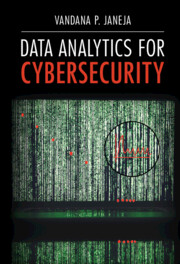Book contents
- Data Analytics for Cybersecurity
- Data Analytics for Cybersecurity
- Copyright page
- Contents
- Preface
- Acknowledgments
- 1 Introduction
- 2 Understanding Sources of Cybersecurity Data
- 3 Introduction to Data Mining
- 4 Big Data Analytics and Its Need for Cybersecurity
- 5 Types of Cyberattacks
- 6 Anomaly Detection for Cybersecurity
- 7 Anomaly Detection Methods
- 8 Cybersecurity through Time Series and Spatial Data
- 9 Cybersecurity through Network and Graph Data
- 10 Human-Centered Data Analytics for Cybersecurity
- 11 Future Directions in Data Analytics for Cybersecurity
- References
- Index
1 - Introduction
Data Analytics for Cybersecurity
Published online by Cambridge University Press: 10 August 2022
- Data Analytics for Cybersecurity
- Data Analytics for Cybersecurity
- Copyright page
- Contents
- Preface
- Acknowledgments
- 1 Introduction
- 2 Understanding Sources of Cybersecurity Data
- 3 Introduction to Data Mining
- 4 Big Data Analytics and Its Need for Cybersecurity
- 5 Types of Cyberattacks
- 6 Anomaly Detection for Cybersecurity
- 7 Anomaly Detection Methods
- 8 Cybersecurity through Time Series and Spatial Data
- 9 Cybersecurity through Network and Graph Data
- 10 Human-Centered Data Analytics for Cybersecurity
- 11 Future Directions in Data Analytics for Cybersecurity
- References
- Index
Summary
This chapter introduces the basic concepts of cybersecurity and the data analytics perspective to cybersecurity. It lays out the areas of study and how data analytics should be a key part of the spectrum of cybersecurity solutions.
Keywords
- Type
- Chapter
- Information
- Data Analytics for Cybersecurity , pp. 1 - 13Publisher: Cambridge University PressPrint publication year: 2022

